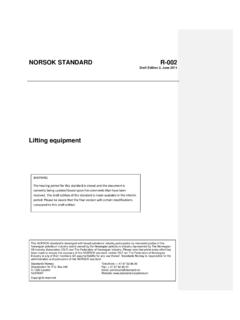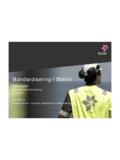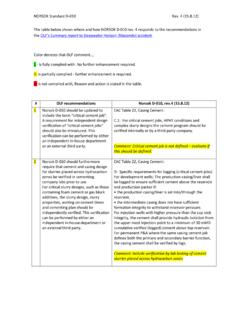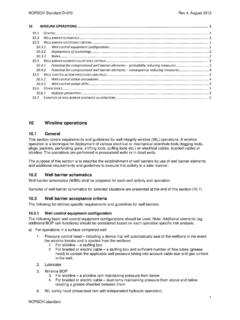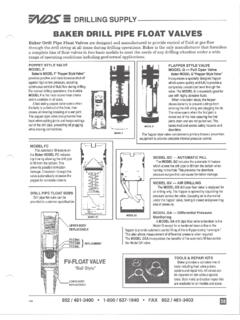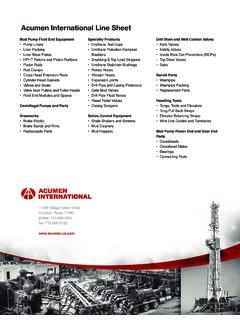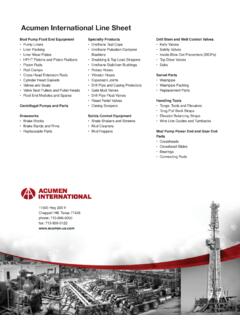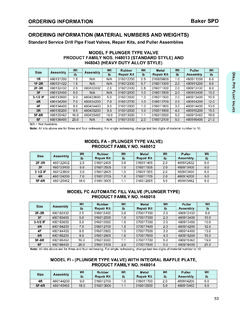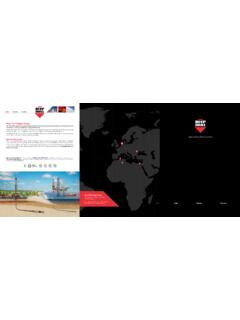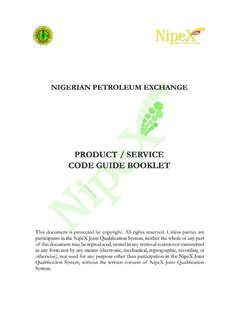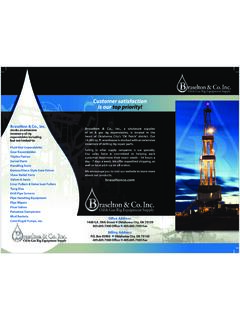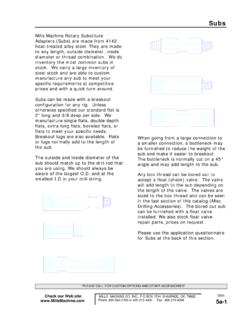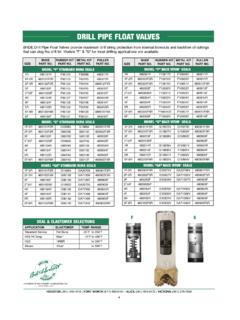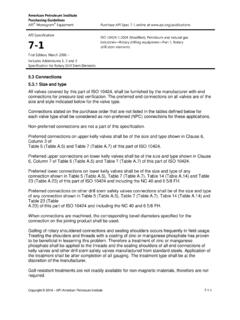Transcription of Table of Contents - Norsk Standard
1 Well barrier elements acceptance tablesSummary of Changes Significant changes Tables 22, 24, 48, 50 New tables 51, 52, 53, 54, 55, 56 All tables - replaced G. Failures modes with Common well barrier Table of Contents 15 Well barrier elements acceptance tables 3 Table 1 Fluid column 4 Table 2 Casing 5 Table 3 drill string 6 Table 4 - Drilling BOP 8 Table 5 Wellhead 10 Table 6 Deep set tubing plug 12 Table 7 Production packer 13 Table 8 Surface controlled sub-surface safety valve 14 Table 9 Annulus surface controlled sub-surface safety valve 15 Table 10 Tubing hanger 16 Table 11 Tubing hanger plug 16 Table 12 Well Head/Annulus access valve 17 Table 13 Coiled tubing 18 Table 14 Coiled tubing BOP 19 Table 15 Coiled tubing check valves 20 Table 16 Coiled tubing safety head 20 Table 17 Coiled tubing strippers 21 Table 18 Snubbing check valves 21 Table 19 Snubbing BOP 22 Table 20 Snubbing stripper 23 Table 21 Snubbing safety head 24 Table 22 Casing cement 25 Table 23 Production tree isolation tool 28 Table 24
2 Cement plug 29 Table 25 Completion string 31 Table 26 High pressure riser 32 Table 27 Well test string 33 Table 28 Mechanical tubular plugs 34 Table 29 Completion string component 35 Table 30 Snubbing string 36 Table 31 Sub-sea production tree 38 Table 32 Sub-sea test tree assembly 39 Table 33 Surface production tree 40 Table 34 Surface test tree 41 Table 35 Well test packer 42 Table 36 Well test string components 43 Table 37 Wireline BOP 44 Table 38 Wireline safety head 45 Table 39 Wireline stuffing box/grease Injection head 46 Table 40 Stab in safety valve 47 Table 41 Casing float valves 47 Table 42 Lower riser package 48 Table 43 Liner top packer 49 Table 44 Wireline lubricator 50 Table 45 Subsea lubricator valve 50 Table 46 Downhole tester valve 51 Table 47 Snubbing stripper BOP 51 Table 48 Rotating control device 53 Table 49 Downhole isolation valve 55 Table 50 UBD/MPD non return valve (NRV) 56 Table 51 Formation 58 Table 52 Shale formation 59 Table 53 UBD/MPD choke system 60 Table 54 Statically Underbalanced Fluid column 62 Table 55 Material Plug 64 Table 56 - Casing bonding material 65 15 Well barrier elements acceptance tables 15 Table 1 Fluid column Features Acceptance criteria See A.
3 Description This is the fluid in the well bore. NORSOK D-001 B. Function The purpose of the fluid column as a well barrier/WBE is to exert a hydrostatic pressure in the well bore that will prevent well influx/inflow (kick) of formation fluid. C. Design construction selection 1. The hydrostatic pressure shall at all times be equal to the estimated or measured pore/reservoir pressure, plus a defined safety margin ( riser margin, trip margin). 2. Critical fluid properties and specifications shall be described prior to any operation. 3. The density shall be stable within specified tolerances under down hole conditions for a specified period of time when no circulation is performed. 4. The hydrostatic pressure should not exceed the formation fracture pressure in the open hole including a safety margin or as defined by the kick margin. 5. Changes in well bore pressure caused by tripping (surge and swab) and circulation of fluid (ECD) should be estimated and included in the above safety margins.
4 ISO 10416 D. Initial test and verification 1. Stable fluid level shall be verified. 2. Critical fluid properties, including density shall be within specifications. E. Use 1. It shall at all times be possible to maintain the fluid level in the well through circulation or by filling. 2. It shall be possible to adjust critical fluid properties to maintain or modify specifications. 3. Acceptable static and dynamic loss rates of fluid to the formation shall be pre-defined. If there is a risk of lost circulation a Lost Circulation Material should be available. 4. There should be sufficient fluid materials, including contingency materials available on the location to maintain the fluid well barrier with the minimum acceptable density. 5. Simultaneous well displacement and transfer to or from the fluid tanks should only be done with a high degree of caution, not affecting the active fluid system. required for re-establishing the fluid well barrier shall be systematically recorded and updated in a killsheet.
5 F. Monitoring 1. Fluid level in the well and active pits shall be monitored continuously. 2. Fluid return rate from the well shall be monitored continuously. 3. Flow checks should be performed upon indications of increased return rate, increased volume in surface pits, increased gas content, flow on connections or at specified regular intervals. The flow check should last for 10 min. HTHP: All flow checks should last 30 min. 4. Measurement of fluid density (in/out) during circulation shall be performed regularly. 5. Measurement of critical fluid properties shall be performed every 12 circulating hours and compared with specified properties. 6. Parameters required for killing of the well . ISO 10414-1 ISO 10414-2 G. Failure modes Common well barrier Non-fulfillment of the above mentioned requirements (shall) and the following: 1. Flow of formation Table 2 Casing Features Acceptance criteria See A. Description This element consists of casing/liner and/or tubing in case tubing is used for through tubing drilling and completion operations.
6 B. Function The purpose of casing/liner is to provide a physical hindrance to uncontrolled flow of formation fluid or injected fluid between the bore and the back-side of the casing. C. Design construction selection 1. Casing-/liner strings, including connections shall be designed to withstand all pressures and loads that can be expected during the lifetime of the well including design factors. 2. Minimum acceptable design factors shall be defined for each load type. Estimated effects of temperature, corrosion and wear shall be included in the design factors. 3. Dimensioning load cases with regards to burst, collapse and tension/compression shall be defined and documented. 4. Casing design can be based on deterministic, probabilistic or other acceptable models. hangers shall have adequate lockdown capacity to guarantee seal integrity during normal working loads as well as well control situations. ISO 11960 API Bull 5C3 API Bull 5C2 D.
7 Initial test and verification 1. Casing/liner shall be leak tested to maximum anticipated differential pressure. 2. Casing/liner that has been drilled through after initial leak test shall be retested during completion activities. leak test of casing shall be performed either when cement is wet or after cement has set up. E. Use 1. Casing/liner should be stored and handled to prevent damage to pipe body and connections prior to installation. ISO 10405 API Bull 5C2 F. Monitoring 1. The A annulus shall be continuously monitored for pressure anomalies. Other accessible annuli shall, if applicable be monitored at regular intervals. 2. If wear conditions exceed the assumptions from the casing-/liner design, indirect or direct wear assessment should be applied ( collection of metal shavings by use of ditch magnets and wear logs). G. Failure modesCommon well barrier Non-fulfillment of the above mentioned requirements (shall) and the following: 1.
8 Leaking casing/liner. 1. The outer/B annuli shall be monitored continuously and alarm levels be defined. 2. Current status of the casing shall be known and be confirmed capable of withstanding maximum expected pressure after expected wear. 3. Pressure test should include safety margin to cover expected wear. 4. Magnet shall be in the flowline to measure metal and assess changes in the nature of the metal filings. 5. If drilling through an old casing; -Casing wear log(s) shall be run (calliper and/or sonic). The logs shall be verified by qualified personnel and documented in a report. -Logs that can identify localised (1 m interval between measurements) doglegs (gyro or similar) shall be run. Table 3 drill string Features Acceptance criteria See A. Description This element consists of drill pipe , heavy weight drill pipe and drill collars used as drill string or work string. B. Function The purpose of the drill string as WBE is to prevent flow of formation fluid from its bore and to the external environment.
9 C. Design construction selection 1. Dimensioning load cases shall be defined and documented. 2. Minimum acceptable design factors shall be defined. Estimated effects of temperature, corrosion, wear; fatigue and buckling shall be included in the design factors. 3. drill pipe should be selected with respect to make-up torque necessary to prevent make-up in the well, tool joint clearance and fishing restrictions, pumping pressure and ECD, abrasive formations, buckling resistance, hard banding and its influence on casing wear, metallurgical composition in relation to exposure tocorrosiveto corrosive environment, fatigue resistance, HPHT: Strength reduction due to temperatures effects. API Spec. 7 ISO 11961 API Bull 5C2 D. Initial test and verification 1. Stable pump pressure when circulating fluid. 2. HPHT: The component of the drill string should be MPI inspected prior to HPHT mode status. E. Use 1.
10 Stab-in safety valve and one way check valve for all type of connections exposed at the drill floor shall be readily available when the drill string is located inside the BOP. 2. Drilling float valves should be installed in the drill string. API RP 7G F. Monitoring 1. Pump pressure shall be continuously monitored for pressure anomalies during circulation. 2. Regular inspection and maintenance based on documented routines shall be conducted. 3. Visual checks for wear, washouts, thread damage and cracks should be conducted regularly. G. Failure modes Common well barrier Non-fulfillment of the above mentioned requirements (shall) and the following: Leaking through drill string ( wash out ). Exposure to H2S (if not designed for it). Inability to document material certificate. None Table 4 - Drilling BOP Features Acceptance criteria See A. Description The element consists of the wellhead connector and drilling BOP with kill/choke line valves .


